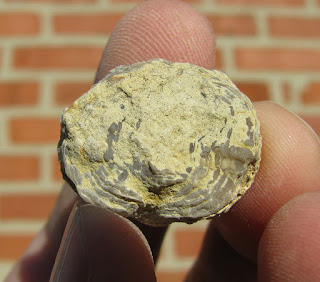Favosites conicus is perhaps the easiest coral to ID from the Bois d'Arc formation. It's typically a small colony that looks like a gumdrop or beehive. The base of the coral colony is flat with a wrinkled epitheca that is indicative of the colony growing on a semisolid substrate. The rest of the colony forms a conical mound composed of interlocking hexagonal cells of varying size. I have not found many that are greater than an inch or two in diameter or height which likely indicates there were frequent storms or other events which prevented large scale colony growth.
Here is a typical specimen viewed in profile from a few angles. It has not been prepped so you can see matrix and other shells still attached.
The underside of the specimen with the epitheca.
Here are a couple of other examples with a side by side comparison. Note that they are more squat than the above specimen.
I know I have some examples of this same species form the Haragan formation but apparently I never wrote a blog about them. I do, however, have examples from the Licking Creek formation of West Virginia and the Kalkberg formation of New York.
I found the specimens shown on this page in the Bois d'Arc formation (Cravatt member) near Clarita, OK which is Devonian in age (Lockhovian stage). The Bois d'Arc and Haragan formations interfinger with each other and are roughly the same age (Devonian, Lockhovian stage). They are both roughly correlative to the Helderberg fauna of New York and thus are contemporaneous with the Coyemans, Kalkberg and New Scotland formations.








No comments:
Post a Comment